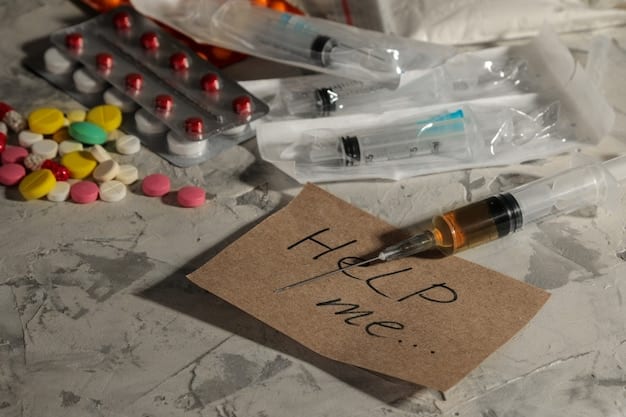Evaluating Opioid Policies: Effectiveness and Reduction Rates in the US

Evaluating the effectiveness of current drug control policies in the US is crucial for understanding impacts on opioid addiction rates, involving assessment of prevention, treatment, and harm reduction strategies alongside law enforcement efforts.
The opioid crisis continues to grip the United States, demanding a critical examination of the strategies employed to combat it. This article delves into evaluating the effectiveness of current drug control policies in reducing opioid addiction rates, exploring the multifaceted approaches and their impact across the nation.
Understanding the Opioid Addiction Crisis in the US
The opioid crisis in the United States has evolved into a significant public health emergency. Understanding the roots and the widespread impact of opioid addiction is the first step in evaluating the policies designed to combat it. This section will explore the scope of the crisis and its devastating effects on communities across the country.
Historical Context of Opioid Use
Opioid use has a long history in the US, but the recent surge in addiction and overdose deaths is unprecedented. The overprescription of opioid painkillers in the late 20th and early 21st centuries played a significant role in creating the current crisis.
Current Statistics and Trends
Statistics paint a stark picture of the ongoing crisis. Overdose deaths involving opioids continue to rise, impacting various demographics and geographic regions. Understanding these trends is crucial for policymakers to tailor interventions effectively.
- The CDC reports that over 70,000 people died from drug overdoses in 2017, with opioids involved in almost 68% of those deaths.
- Synthetic opioids, like fentanyl, are now the leading cause of opioid-related deaths.
- Rural and urban communities alike are affected, with certain areas experiencing disproportionately high rates of addiction and overdose.
The opioid crisis is a complex and multifaceted problem. By understanding its scope and historical context, we can better assess the effectiveness of current drug control policies and identify areas for improvement. This foundational knowledge helps in shaping strategies that are more targeted, comprehensive, and ultimately, more effective in reducing opioid addiction rates.

Overview of Current Drug Control Policies
Combating the opioid crisis requires a multi-pronged approach involving a range of policies and strategies. Understanding the current drug control policies is essential for assessing their effectiveness in reducing opioid addiction rates. This section offers an overview of the strategies currently in place, focusing on prevention, treatment, and law enforcement.
Prevention Strategies
Prevention is a key component of any successful drug control policy. These strategies aim to reduce the likelihood of individuals starting opioid use and prevent addiction before it begins. Education, early intervention programs, and prescription drug monitoring are crucial.
Treatment Options and Accessibility
Effective treatment is vital for individuals struggling with opioid addiction. Treatment options include medication-assisted treatment (MAT), behavioral therapies, and support groups. Ensuring accessible and affordable treatment is a significant challenge.
- Medication-assisted treatment (MAT), using drugs like methadone and buprenorphine, is shown to be effective in reducing opioid cravings and withdrawal symptoms.
- Behavioral therapies, such as cognitive-behavioral therapy (CBT) and contingency management, help individuals develop coping skills and reduce drug-seeking behaviors.
- Access to treatment remains a barrier, particularly in rural and underserved communities.
Current drug control policies encompass a wide array of strategies aimed at prevention, treatment, and law enforcement. Evaluating the effectiveness of these policies is critical for optimizing efforts and achieving meaningful reductions in opioid addiction rates. A comprehensive and balanced approach that addresses all aspects of the crisis is essential for long-term success.
Assessing the Impact of Prevention Programs
Prevention programs play a crucial role in reducing opioid addiction rates by targeting at-risk populations and educating the public. Assessing the true impact of these programs requires careful evaluation of their design, implementation, and outcomes. This section will delve into the various types of prevention programs and examine their effectiveness in preventing opioid addiction.
Types of Prevention Programs
Prevention programs vary widely, ranging from school-based education to community-wide awareness campaigns. These programs aim to educate individuals about the risks of opioid use and provide them with the skills and resources needed to make informed decisions.
Challenges in Evaluating Prevention Programs
Evaluating the effectiveness of prevention programs can be challenging due to a number of factors. Measuring long-term outcomes, attributing changes solely to prevention efforts, and reaching the most at-risk populations are common hurdles.
Effective prevention programs share several key characteristics:
• They are evidence-based and tailored to meet the specific needs of the target population.
• They involve multiple interventions, such as education, media campaigns, and community outreach.
• They are culturally sensitive and address the underlying social and economic factors that contribute to opioid abuse.

Effectiveness of Treatment Approaches
Effective treatment is crucial for individuals struggling with opioid addiction and a key component of reducing overall addiction rates. Assessing the effectiveness of different treatment approaches, including medication-assisted treatment (MAT) and behavioral therapies, is essential. This section will explore the efficacy of various treatment strategies and the factors that contribute to successful recovery.
Medication-Assisted Treatment (MAT)
MAT involves the use of medications, such as methadone and buprenorphine, in combination with counseling and behavioral therapies. This approach has been shown to be highly effective in reducing opioid cravings and withdrawal symptoms.
Behavioral Therapies
Behavioral therapies, such as cognitive-behavioral therapy (CBT) and contingency management, play a vital role in helping individuals develop coping skills, manage triggers, and prevent relapse. These therapies address the underlying psychological and behavioral factors that contribute to addiction.
- Cognitive-behavioral therapy (CBT) helps individuals identify and change negative thinking patterns and behaviors associated with drug use.
- Contingency management provides incentives for individuals to remain drug-free, such as vouchers or prizes for negative drug tests.
- Motivational interviewing enhances an individual’s motivation to change and commit to treatment.
Successful treatment requires a comprehensive and individualized approach. Factors such as access to care, adherence to treatment plans, and the availability of supportive services can significantly impact outcomes. By combining medication-assisted treatment with behavioral therapies and addressing individual needs, treatment programs can achieve meaningful reductions in opioid addiction rates.
The Role of Law Enforcement in Opioid Control
Law enforcement plays a significant role in drug control efforts aimed at reducing opioid addiction rates. Understanding the different approaches used by law enforcement and their impact on the opioid crisis is essential. This section will examine strategies, including drug interdiction and the prosecution of drug traffickers, as well as community policing initiatives that aim to address the underlying causes of addiction.
Drug Interdiction and Prosecution
Drug interdiction involves efforts to intercept and seize illicit drugs as they are transported across borders or within communities. Prosecuting drug traffickers aims to disrupt the supply chain and hold those responsible for distributing opioids accountable.
Community Policing and Harm Reduction
Community policing focuses on building relationships between law enforcement and the communities they serve. Harm reduction strategies aim to minimize the negative consequences associated with drug use, such as overdose deaths and the spread of infectious diseases.
The effectiveness of law enforcement strategies in reducing opioid addiction rates is a complex issue. Some argue that strict enforcement can deter drug use and disrupt criminal organizations, while others contend that it can exacerbate the problem by driving drug use underground and increasing the risk of overdose.
Effective law enforcement strategies balance enforcement with prevention and treatment efforts. Collaboration between law enforcement, public health agencies, and community organizations is essential for addressing the opioid crisis in a comprehensive and sustainable way.
Harm Reduction Strategies and Their Effectiveness
Harm reduction strategies aim to minimize the negative consequences associated with drug use, such as overdose deaths and the spread of infectious diseases. Understanding the impact of these strategies on opioid addiction rates is essential for developing comprehensive and effective drug control policies. This section will examine various approaches, including naloxone distribution and safe injection sites.
Naloxone Distribution
Naloxone is a medication that can rapidly reverse an opioid overdose. Distributing naloxone to first responders, drug users, and their families can save lives and reduce overdose fatalities. Many states have implemented naloxone distribution programs to increase access to this life-saving medication.
Safe Injection Sites
Safe injection sites, also known as supervised consumption sites, provide a safe and hygienic environment for individuals to use drugs under medical supervision. These sites aim to reduce overdose deaths, prevent the spread of infectious diseases, and connect drug users with treatment and other services. Safe injection sites are controversial but have been shown to be effective in reducing harm in other countries.
- Safe injection sites provide a safe and hygienic environment for drug use, reducing the risk of overdose and infection.
- These sites offer opportunities for healthcare professionals to engage with drug users and connect them with treatment and support services.
- Naloxone distribution programs increase access to this life-saving medication, enabling first responders and community members to reverse opioid overdoses.
Harm reduction strategies can play a crucial role in reducing the negative consequences of drug use and improving public health outcomes. By focusing on harm reduction, communities can save lives, reduce the spread of infectious diseases, and provide individuals with pathways to treatment and recovery.
Policy Recommendations and Future Directions
Addressing the opioid crisis requires a comprehensive and evidence-based approach that integrates prevention, treatment, law enforcement, and harm reduction strategies. This section will provide policy recommendations and future directions for reducing opioid addiction rates in the United States.
Integrated and Comprehensive Approach
An integrated approach involves coordinating efforts across various sectors, including healthcare, law enforcement, education, and community organizations. A comprehensive approach addresses the underlying social, economic, and environmental factors that contribute to opioid abuse.
Investment in Research and Data Collection
Investing in research and data collection is essential for monitoring trends, evaluating the effectiveness of interventions, and identifying emerging challenges. Data-driven strategies can help policymakers make informed decisions and allocate resources effectively.
Future drug control policies should focus on the following:
• Expanding access to treatment and recovery services, particularly in underserved communities.
• Implementing evidence-based prevention programs that target at-risk populations.
• Promoting harm reduction strategies, such as naloxone distribution and safe injection sites.
• Strengthening law enforcement efforts to disrupt the supply of illicit opioids.
By adopting these policy recommendations and future directions, the United States can make significant progress in reducing opioid addiction rates and mitigating the devastating consequences of the opioid crisis.
| Key Point | Brief Description |
|---|---|
| 💊 MAT Effectiveness | Medication-assisted treatment reduces opioid cravings and withdrawal. |
| 🛡️ Harm Reduction | Naloxone distribution saves lives by reversing opioid overdoses. |
| 🤝 Community Policing | Builds trust, addresses addiction’s root causes. |
| 📚 Prevention Programs | Evidence-based programs educate and prevent opioid misuse. |
Retractable FAQ Section –>
Opioid Policies
▼
The main goals include reducing opioid addiction rates, preventing overdose deaths, disrupting the drug supply, and providing access to treatment and recovery services for those affected by opioid use disorder.
▼
MAT, involving medications like methadone and buprenorphine, combined with counseling, is highly effective. It reduces cravings, withdrawal symptoms, and the risk of relapse, improving overall treatment outcomes for those addicted.
▼
Harm reduction strategies, such as naloxone distribution, safe injection sites, and syringe exchange programs, aim to minimize the negative consequences of drug use, including overdose deaths and the spread of infectious diseases.
▼
Law enforcement plays a role through drug interdiction, prosecution of traffickers, and community policing initiatives. Their efforts are intended to disrupt the drug supply, hold offenders accountable, and build trust with communities.
▼
Future directions include expanding access to treatment, implementing evidence-based prevention programs, promoting harm reduction strategies, investing in research, and fostering collaboration among healthcare, law enforcement, and community organizations.
Conclusion
Evaluating the effectiveness of current drug control policies in reducing opioid addiction rates requires a multifaceted approach, carefully considering the impact of prevention programs, treatment options, law enforcement strategies, and harm reduction measures. By integrating these elements and investing in data-driven strategies, the United States can make significant strides in combating the opioid crisis and saving lives.





